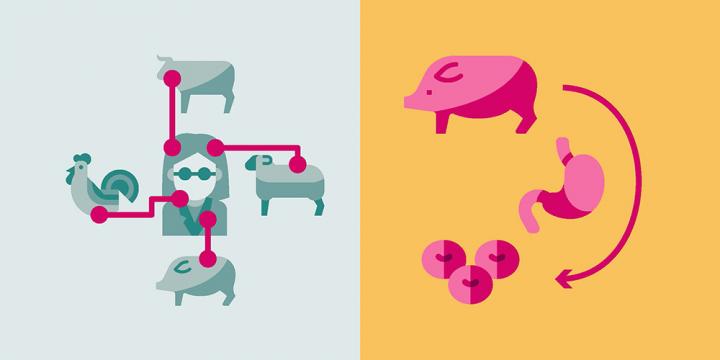New research platforms help understand disease
Developing novel ways to refine, reduce and replace the use of animals in research and enhance animal and human health.

Roslin researchers are striving to develop novel ways to refine, reduce and replace the use of animals in research. Their work will be supported by the recently opened Large Animal Research and Imaging Facility (LARIF) on campus.
Farm animal studies
Similarities between large animals and people in terms of DNA, physiology and anatomy can make studies of human disease in farm animals, such as sheep and pigs, more relevant than research in rodents or cells.
Roslin scientists have generated genome-edited sheep with a genetic condition that mirrors human Batten disease – a rare nervous system disorder causing dementia, sight loss and early death in children.
The approach should enable studies into the disease and potential treatments, and has led to £400,000 funding from industry.
Similar strategies have been used to model cystic fibrosis in sheep, by introducing a genetic mutation that is found in humans with the condition. This is in support of a consortium project to pioneer a gene therapy for the disease, which would use viruses to introduce a functional copy of the gene.
This will be further enabled by work to develop a sheep model of chronic lung infections that are common in cystic fibrosis patients.
Research involving chickens will enable Roslin scientists to study inherited human eye disorders linked to blindness. Gene-editing and imaging techniques will be applied to the study of chick embryos to shed light on key stages of development and important genetic mutations.
A team involving Roslin researchers is developing a sensory implant to monitor tumours, in studies of sheep with naturally occurring lung cancer.
The devices in development, composed of biosensors mounted on a microelectronic chip, could transform personalised care for cancer patients by delivering details of the status of a tumour in real time.
They could also have applications monitoring deep wounds, delivering drugs to the site of a tumour, or tracking the status of newly transplanted organs.
Stem cells and mini-organs
Research into infectious disease and tissue development and function is being accelerated by the development of models using stem cells – undeveloped cells that will later form a particular tissue type – and organoid systems – a mass of cells that resembles a miniature organ.
This approach lowers the cost and time needed for experiments, curbs the use of live animals and enables multiple experiments to be carried out in a relatively short time.
Researchers have defined how to maintain stem cells from pigs and how to promote their differentiation into other types of cells, such as brain cells, heart muscle cells and macrophages –a key cell type in the immune system.
Pig macrophages from stem cells were found to be a useful way to study African Swine Fever, as cells from different pig species infected in the laboratory mirrored the animals’ varying susceptibility to disease.
Research is ongoing to analyse inherited traits in these cells, as an alternative to causing disease in pigs.
Masses of cells resembling miniature guts – enteroids – which can be maintained over the long-term, frozen and recovered, have been developed by Roslin scientists as models for research. This has been applied to cattle, and methods to repeat the process for pigs and chickens have also been devised.
Cattle enteroids have been used to understand the role of a bacterial toxin during E. coli O157 infection, which is being extended to Cryptosporidium and Salmonella.
Patent protection is being sought for chicken enteroid models developed at Roslin, which have potential for the study of vaccines, feed additives and novel antibiotics.
Researchers have developed rat and mouse embryonic stem cells carrying a range of fluorescent markers linked to particular cell states, to investigate cellular systems.
Studies of stem cells have increased understanding of their resilience in poor nutritional conditions, offering the potential to improve early embryo survival.
Genetic insights
Researchers are using a gene-editing screening technique called GeCKO (genome-scale CRISPR-Cas9 knockout) to investigate gene and regulatory functions in cell lines without the need to generate breeding colonies. The approach is used to study populations exposed naturally or experimentally to pathogens, accelerating progress and reducing the numbers of animals used in research.
A recently funded Doctoral Training Programme will build on the use of large animal models, with the work to be undertaken at the Large Animal Research and Imaging Facility.
The programme, funded by Wellcome, will support research into One Health models of disease – impacting on people, animals, agriculture and the environment.
Technology enabling large-scale, or high-throughput, sequencing of DNA samples has enabled comparison of bacterial pathogens found in various species.
Such studies are providing insights into the evolutionary processes that allow bacteria to adapt to cause new infections. Improved understanding of this may point towards ways of controlling infection or inform the design of approaches to limit the emergence of new types of infections.
Research has predicted variants of Salmonella typhimurium that may differ in their effect on various farm animals, their ability to cause disease and their risk of transferring to other species.
A method of evaluating strains of the bacteria, using a powerful computing approach, could offer useful insight with limited use of animals in research.
Related links
Sheep research could aid insights into childhood dementia
Eye disease patients to benefit from chicken study
Dr Gerry McLachlan on cystic fibrosis
Implantable Microsystems for Personalised Anti-Cancer Therapy
Graphics: Elena Bernabeu at Colored In Science


